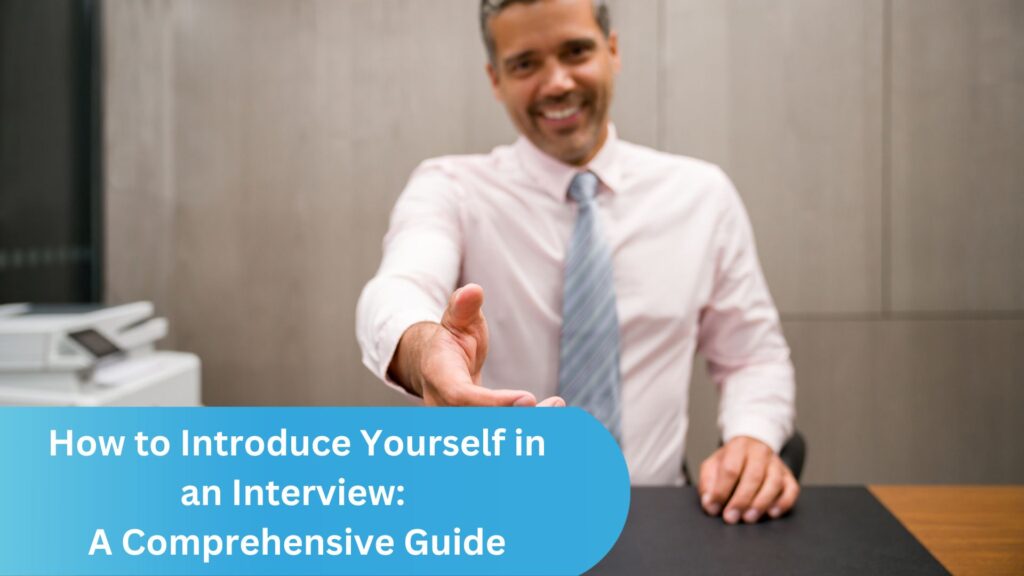Your self-introduction in a job interview is more than just stating your name — it’s your first opportunity to make a powerful, memorable impression. A strong introduction sets a confident tone, builds rapport, and immediately communicates your professionalism and enthusiasm for the role.
Whether you’re interviewing in person, via phone, or over video, knowing how to introduce yourself effectively can help you stand out from other candidates.
Why Your Introduction Matters?
First Impressions Count
Studies show that interviewers form opinions about candidates within the first 30 seconds of meeting them. That means your tone, body language, and opening words can have a lasting impact. A well-prepared introduction can:
-
Convey confidence and clarity
-
Demonstrate professionalism and enthusiasm
-
Set the stage for deeper discussion about your skills and experience
Even a simple greeting like, “Hi, I’m Alex, and I’m excited to be here to talk about how my background in digital marketing aligns with your brand’s growth goals,” can make a stronger impression than a generic “Hi, I’m Alex.”
Opportunity to Align with the Role
Your self-introduction isn’t just about who you are — it’s about why you’re the right fit. Use it to bridge your personal background and the company’s needs:
-
Mention your current role or area of expertise
-
Briefly summarize your most relevant achievements
-
Tie it to what excites you about this opportunity
For example:
“I’m currently a logistics coordinator with three years of experience optimizing supply chains for retail companies. I’m especially interested in this role because your focus on sustainable transportation aligns with my passion for eco-efficient operations.”
This kind of targeted introduction shows you’ve done your research and understand how you can contribute — which interviewers love to hear.
Sets the Tone for the Interview
The introduction also shapes how comfortable and natural the rest of your conversation will feel. When you start with a confident, engaging self-introduction, it invites the interviewer to connect with you more personally. It shows you’re prepared, articulate, and motivated — all qualities hiring managers seek.
Think of your introduction as the headline of your interview story. It should grab attention, summarize your value, and make them want to learn more.
How to Prepare for your Interview’s First Impression?

Preparing your self-introduction before the interview ensures you come across as confident, polished, and professional. Here’s a clear structure to follow — along with examples for each step.
1. Start with a Warm Greeting
Begin with a friendly and respectful greeting to establish a positive tone. Address the interviewer by name if you know it, and include the job title to show attentiveness.
💡 Pro Tip: Smile, make eye contact (or look into the camera if it’s virtual), and maintain good posture — first impressions start before you even speak.
Example:
“Good morning, Ms. Smith. Thank you for the opportunity to interview for the Marketing Manager position.”
2. Provide a Brief Personal Introduction
After greeting, clearly state your name and share a concise summary of who you are professionally. This should highlight your current role, years of experience, and key areas of expertise.
Example:
“My name is Alex Johnson, and I have over five years of experience in digital marketing, specializing in SEO and content strategy.”
💬 Keep it short — one or two sentences are enough. The goal is to give the interviewer a quick snapshot of your background, not your entire resume.
3. Highlight Key Achievements
Next, share one or two notable accomplishments that show the impact you’ve made in past roles. Focus on results that are relevant to the position you’re interviewing for. Quantify your results whenever possible — numbers build credibility.
Example:
“In my previous role at XYZ Corp, I led a team that increased organic traffic by 40% in six months through targeted SEO campaigns and data-driven content planning.”
💡 Pro Tip: Choose achievements that demonstrate problem-solving, leadership, or innovation — traits every employer values.
4. Connect Your Background to the Role
This is the bridge between who you are and why you’re here. Use this part to show enthusiasm for the company and highlight how your skills match what they’re looking for.
Example:
“I’m excited about the opportunity to bring my expertise in SEO and content strategy to your team, especially since your company is known for its innovative approach to digital marketing.”
This step shows you’ve done your research and genuinely want to contribute to this specific organization — not just land any job.
5. Conclude with Enthusiasm
End on a confident and forward-looking note. Express appreciation for the opportunity and reinforce your eagerness to add value.
Example:
“I’m looking forward to discussing how my experience and creative approach can help your marketing team achieve its growth goals.”
💡 Pro Tip: Keep your tone authentic and positive. Confidence combined with gratitude leaves a strong final impression.
Quick Summary: Self-Introduction Formula
You can summarize this structure into a simple formula:
Greeting → Professional Summary → Key Achievement → Connection to Role → Confident Close
Practicing this formula ensures your introduction feels natural and professional — even under pressure.
Real-World Interview Examples for First Introduction

Below are examples of how to introduce yourself in different career stages — use them as templates to craft your own confident introduction.
Entry-Level Candidate Example
“Good afternoon, my name is Sarah Lee. I recently graduated with a degree in Computer Science from ABC University. During my internship at Tech Solutions, I developed a mobile application that improved user engagement by 25%. I’m eager to apply my skills in software development and problem-solving to contribute to your team’s success.”
Why it works:
This introduction balances education, practical experience, and enthusiasm. It shows initiative and measurable results — even from a short-term internship.
Mid-Career Professional Example
“Hello, I’m David Kim, a seasoned project manager with over ten years of experience in the construction industry. I’ve successfully led cross-functional teams to complete multimillion-dollar projects on time and under budget. I’m excited about the opportunity to bring my expertise in leadership, scheduling, and stakeholder management to your organization.”
Why it works:
This example clearly communicates seniority, measurable impact, and leadership — all traits hiring managers look for in mid-career candidates.
Career Changer Example
“Hi, I’m Jasmine Patel. After five years in retail management, I’m transitioning into HR because I’ve developed a passion for employee development and team culture. My background in managing and training teams gives me a strong foundation for building positive workplace environments.”
Why it works:
Career changers must show transferable skills — this example highlights leadership and people management while explaining the reason for the shift.
Tips for a Successful Introduction at your Interview

A strong introduction can set you apart within seconds.
Here’s how to perfect it:
-
Be Concise:
Keep your introduction under one minute. Focus on the most relevant skills, experiences, and goals. -
Practice with Purpose:
Rehearse your introduction until it feels natural — not robotic. Practice in front of a mirror or record yourself to refine tone and confidence. -
Tailor It to the Role:
Research the company’s values, mission, and current challenges. Weave in how your experience or skills align with their goals. -
Be Authentic:
Employers value honesty and genuine enthusiasm. Don’t try to sound overly rehearsed — your goal is connection, not perfection. -
End with Forward Energy:
Use your closing line to show excitement for contributing to the company. Example:“I’m excited to learn more about how I can add value to your team.”
What are the Most Common Mistakes to Avoid as a First Impression?
Avoid these pitfalls that can weaken your first impression:
-
Overloading with Information:
Your introduction isn’t your full resume — just the highlights. Stick to 3–4 sentences. -
Being Overly Modest or Boastful:
Confidence is key, but humility builds likability. Share accomplishments factually — let results speak for themselves. -
Lack of Preparation:
“Winging it” can cause rambling or hesitation. A clear, practiced structure shows professionalism. -
Ignoring Body Language:
Maintain open posture, eye contact, and a smile. Nonverbal confidence often speaks louder than words.
Final Thoughts
Your self-introduction is more than a formality — it’s your opening pitch. A confident, tailored introduction can immediately position you as a capable, enthusiastic, and prepared candidate.
Remember: interviews are a two-way conversation. By introducing yourself clearly and authentically, you set the tone for meaningful dialogue — and increase your chances of landing the job.
How WiseWorq Can Help
Before your interview, take time to research what it’s really like to work at the company. WiseWorq provides verified employee reviews, insights, and company culture details for 26,000+ U.S. employers — helping you prepare smarter and ask better questions during your interview.
👉 Explore real company insights today at wiseworq!

